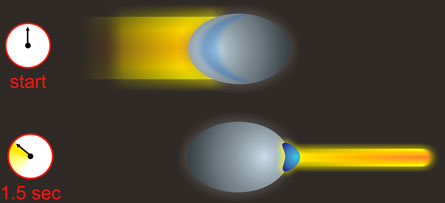A light delay
New kind of trap can hold light for 1.5 seconds
 | ||
|
| ||
| Anne Goodsell |
It’s easy to imagine catching a ball, holding it for a moment and then throwing it in the air again. It’s also easy to imagine scooping up a handful of water — say, from the ocean — and then releasing it again. But what about light? Is it possible to “catch” light — and then let it go?
Scientists from Harvard University recently demonstrated a way to catch and release light—but it’s not easy. In other words, no one will be using the new method to play a game of catch with flashlight beams anytime soon. The researchers were able to build a trap that held light for about 1.5 seconds. That may not seem like much time to hold anything, but 1.5 seconds is enough time for light from the moon to reach Earth.
Lene Hau is the physicist who led this study of how to stop and release light. Physicists study matter, energy and motion. In the case of Hau’s experiment, she had to use her knowledge of all three.
The light trap wasn’t built from normal materials. Hau and her team instead used a material called a Bose-Einstein condensate, or BEC. This material is unusual because it does not represent any of matter’s usual states: solid, liquid or gas. It’s not even a plasma, the fourth state of matter found in high-energy experiments and on the sun.
Instead, BECs are a fifth state of matter. They exist only at the coldest possible temperatures, a fraction of a degree above absolute zero. (Absolute zero is the coldest possible temperature in the universe. It’s so cold that not even atoms can move around.) BECs are one of the strangest known materials. Solids, liquids, gases and plasmas are all made up of individual atoms. But when some materials are cooled to almost absolute zero, their atoms seem to collapse into one teeny-tiny blob, and that blob is called a BEC.
The scientists used a BEC to stop light in a way similar to the game of Gossip (also known as Telephone, or Whisper Down the Lane). It’s an easy game to play: One person whispers a message to a second person, who listens. That person then turns to a third person and passes on the message. The third person should now have the same message as the one sent by the first person (though it might be slightly different). In Hau’s experiment, the light is like the message, and the BEC is like the person in the middle — who hears the message and then passes it on.
Hau and her team fired a pulse of light into a BEC — so they had to do their experiment at very cold temperatures — and the light changed a small group of atoms. These changed atoms (called an imprint) dug a little hole for themselves in the BEC — like a footprint. The research team then turned off a control laser, which made the light’s footprint “sit” in the BEC. “It can snugly sit there for long periods of time,” Hau told Science News.
The scientists waited for 1.5 seconds and then turned the control laser back on. When they did, the trapped light pulse came out of the BEC.
Just as the message at the end of the game of Gossip might be slightly different than it was at the beginning, the light pulse was a little weaker than it was when it started. And just as the middle person in Gossip uses the memory of the message she has stored in her brain to pass the message on, the BEC uses the imprint to transmit the pulse of light.
Finding new ways to control light might pave the way for the development of technology that uses light to store and transmit information. Researchers have been working on ways to stop and release light for years, but the Harvard team says its approach is better in some ways than attempts in the past. Another physicist, Irina Novikova, who works at the College of William & Mary in Williamsburg, Va., said that Hau’s work is a “beautiful demonstration” of how it is possible to catch light for a long period of time before releasing it.
POWER WORDS (adapted from the Yahoo! Kids Dictionary and other sources)
Bose-Einstein condensate A state of matter that forms below a critical temperature in which all bosons (a type of subatomic particle) that comprise the matter fall into the same quantum state.
gas The state of matter distinguished from the solid and liquid states by relatively low density and viscosity (stickiness), relatively great expansion and contraction with changes in pressure and temperature, and the spontaneous tendency to become distributed evenly throughout any container.
liquid The state of matter in which a substance can flow easily, does not tend to disperse, and is difficult to compress.
solid The state of matter in which a substance is not liquid or gaseous, but rather has a definite shape and volume.
plasma An electrically neutral, highly ionized gas made of ions, electrons and neutral particles. It is a state of matter distinct from solids, liquids and normal gases.
physics The science of matter and energy and of interactions between the two, grouped in traditional fields such as acoustics, optics, mechanics, thermodynamics and electromagnetism, as well as in modern fields including atomic and nuclear physics, solid-state physics, particle physics and plasma physics.
Going Deeper:







